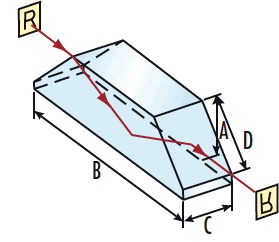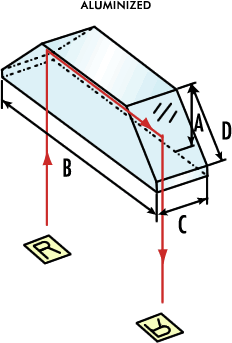
 TECHSPEC® components are designed, specified, or manufactured by Edmund Optics. Learn More
TECHSPEC® components are designed, specified, or manufactured by Edmund Optics. Learn More
TECHSPEC® Dove Prisms have an unusual and fascinating characteristic. If you look through the prism and rotate it around a longitudinal axis, the image rotates through twice the angle through which the dove prism itself rotates. For optimal performance, use dove prisms with collimated light. The top surface of each dove prism is ground, and the longest length (specified by dimension B) features an unbeveled sharp edge. TECHSPEC® Dove Prisms are offered uncoated, with anti-reflection coated diagonal faces or with aluminized diagonal faces. Aluminized dove prisms feature a protected aluminum coating with black Krylon paint on the diagonal faces and are ideal for displaced retroreflection. They provide a U-turn for incident laser beam light.
Reflection is displaced 49mm (in 15mm sizes) or 75mm (in 25mm sizes) when incident rays are centered on the diagonal face. Aluminized TECHSPEC® Dove Prisms can be used in imaging systems (with fields of view less than dimension A/ dimension C) to view areas behind the camera or around corners. They can also provide a split image, where one scene is displaced relative to the other.


1-800-363-1992
or view regional numbers
QUOTE TOOL
enter stock numbers to begin
Copyright 2025 | Edmund Optics, Ltd Unit 1, Opus Avenue, Nether Poppleton, York, YO26 6BL, UK
California Consumer Privacy Acts (CCPA): Do Not Sell or Share My Personal Information
California Transparency in Supply Chains Act